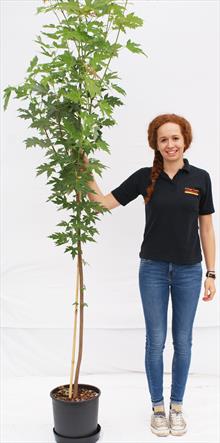Sugar Maple
Acer saccharumThe Sugar Maple is the species you need if you intend to produce your own maple syrup. However while this species can grow successfully in the UK, our maritime climate, and particularly our mild winters, mean sap production is not commercially viable - although you could still collect a small quantity for tasting purposes once the tree is large enough.
Fortunately the Sugar Maple is also one of the most spectacular maple species when it comes to autumn leaf colour. The best colours arise in climates where autumn nights are cool and days still warm and sunny.
Sugar Maple maple trees for sale

All our pot-grown trees are grown for us to our specification by the Frank P Matthews nursery.
All pot-grown trees are suitable for planting out in the garden, some are suitable for growing in containers.
2-year pot-grown
tree
£75.00
Grown for us by Frank P Matthews nursery
In a 12L pot
Very large size (4m-7m after 10 years)
Out of stock
Sorry we have sold out for this season
History
The Sugar Maple, also known as the Rock Maple, is native to the north-east of the USA and Canada, particularly around the Great Lakes. The sap of many other maple species can also be used to produce maple syrup, but the sap of the Sugar Maple is the clearest and sweetest.
You can find more about maple syrup production from the Vermont Maple Sugar Makers Assocation.
As well as being the main source of maple syrup, and a popular ornamental tree, the mature wood of this maple species also has excellent tonal qualities. It is the main wood used in the construction of Rickenbacker electric guitars (the grain can be seen most clearly in their natural "Mapleglo" colour range, as shown in our photograph). It is also often used for the necks of Fender Telecaster and Stratocaster guitars. The grain contours are particularly attractive, often with interesting "birds-eye" patterns.
The Sugar Maple is closely associated with Canada, but the maple leaf on the Canadian flag is a generic stylised maple leaf, and not necessarily a Sugar Maple leaf.
The Sugar Maple is often confused with the Silver Maple on account of their similar Latin species names - Acer saccharum and Acer saccharinum respectively.
Sugar Maple characteristics
- Gardening skillBeginner
- Attractive featuresAutumn foliage colour
- Growth habitUpright-spreading / Vase
- Height after 10 years3m-5m / 10ft-16ft
- SunlightPrefers full sun
- WildlifeRHS Plants for Pollinators
- Leaf colour - autumnMultiple tints
- Country of originCanada
- Annual cycleDeciduous
Similar varieties
Acer saccharinumSilver MapleA large stately tree featuring attractive cut leaves which turn yellow and gold in the autumn.
What will it look like?
Illustrative example of a pot-grown tree of this variety as supplied.
Approximate girth: 6/8cm. We try to keep all pot-grown trees down to about 1.5m as supplied, but some may be larger.
Trees should reach their mature height after about 10 or more years.

 Over 400 varieties of flowering cherries, crab apples, rowans and other ornamental trees.
Over 400 varieties of flowering cherries, crab apples, rowans and other ornamental trees.